Table of Contents
ToggleClass 10 maths 14.1NCERT solutions
NCERT Solutions For Class 10 Maths Chapter 14 Probability Ex -14.1
Download the free NCERT Maths Chapter 14 Solutions for Class 10 here Probability in Maths Class 10 NCERT Solutions are a great resource for homework assistance. For class 10 maths 14.1 NCERT solutions Expert Bhautikstudy.com Teachers developed the NCERT Solutions. Complete solutions to all the problems in NCERT Textbook’s Chapter 14 Math Class 10 Probability Exercise 14.1.
Class 10 Maths 14.1 NCERT Solutions Question 1.
1. Complete the following statements:
(i) Probability of an event E + Probability of the event ‘not E’ = ___________.
(ii) The probability of an event that cannot happen is __________. Such an event is called ________.
(iii) The probability of an event that is certain to happen is _________. Such an event is called _________.
(iv) The sum of the probabilities of all the elementary events of an experiment is __________.
(v) The probability of an event is greater than or equal to ___ and less than or equal to __________.
Solution:
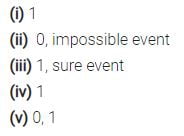
Class 10 Maths 14.1 NCERT Solutions Question 2.
2. Which of the following experiments have equally likely outcomes? Explain.
(i) A driver attempts to start a car. The car starts or does not start.
(ii) A player attempts to shoot a basketball. She/he shoots or misses the shot.
(iii) A trial is made to a solution: a true-false question. The solution is right or wrong.
(iv) A baby is born. It is a boy or a girl.
Solution:

Class 10 Maths 14.1 NCERT Solutions Question 3.
3. Why is tossing a coin considered to be a fair way of deciding which team should get the ball at the beginning of a football game?
Solution:

Class 10 Maths 14.1 NCERT Solutions Question 4.
4. Which of the following cannot be the probability of an event?
(A) 2/3, (B) -1.5, (C) 15%, (D) 0.7
Solution:

Class 10 Maths 14.1 NCERT Solutions Question 5.
5. If P(E) = 0.05, what is the probability of ‘not E’?
Solution:
Class 10 Maths 14.1 NCERT Solutions Question 6.
6. A bag contains lemon-flavoured candies only. Malini takes out one candy without looking into the bag. What is the probability that she will take out
(i) an orange-flavoured candy?
(ii) a lemon-flavoured candy?
Solution:

Class 10 Maths 14.1 NCERT Solutions Question 7.
7. It is given that in a group of 3 students, the probability of 2 students not having the same birthday is 0.992. What is the probability that the 2 students have the same birthday?
Solution:

Class 10 Maths 14.1 NCERT Solutions Question 8.
8. A bag contains 3 red balls and 5 black balls. A ball is drawn at random from the bag. What is the probability that the ball drawn is
(i) red?
(ii) not red?
Solution:

Class 10 Maths 14.1 NCERT Solutions Question 9.
9. A box contains 5 red marbles, 8 white marbles and 4 green marbles. One marble is taken out of the box at random. What is the probability that the marble taken out will be
(i) red?
(ii) white?
(iii) not green?
Solution:
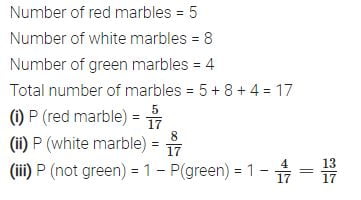
Class 10 Maths 14.1 NCERT Solutions Question 10.
10. A piggy bank contains hundred 50p coins, fifty ₹1 coins, twenty ₹2 coins and ten ₹5 coins. If it is equally likely that one of the coins will fall out when the bank is turned upside down, what is the probability that the coin
(i) will be a 50 p coin?
(ii) will not be a ₹5 coin?
Solution:
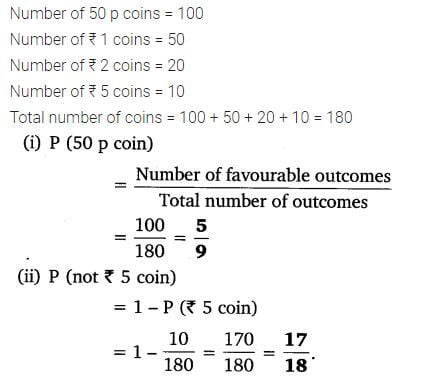
Class 10 Maths 14.1 NCERT Solutions Question 11.
11. Gopi buys a fish from a shop for his aquarium. The shopkeeper takes out one fish at random from a tank containing 5 male fish and 8 female fish (see Fig. 15.4). What is the probability that the fish taken out is a male fish?

Solution:

Class 10 Maths 14.1 NCERT Solutions Question 12.
12. A game of chance consists of spinning an arrow which comes to rest, pointing at one of the numbers 1, 2, 3, 4, 5, 6, 7, 8 (see Fig. 15.5), and these are equally likely outcomes. What is the probability that it will point at
(i) 8?
(ii) an odd number?
(iii) a number greater than 2?
(iv) a number less than 9?

Solution:
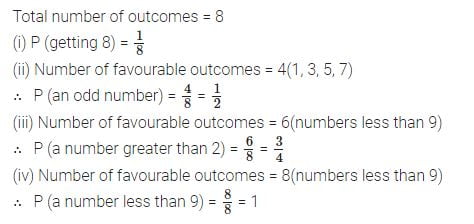
Class 10 Maths 14.1 NCERT Solutions Question 13.
13. A die is thrown once. Find the probability of getting
(i) a prime number
(ii) a number lying between 2 and 6
(iii) an odd number
Solution:
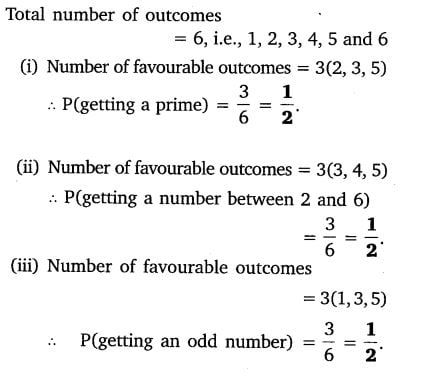
Class 10 Maths 14.1 NCERT Solutions Question 14.
14. One card is drawn from a well-shuffled deck of 52 cards. Find the probability of getting
(i) a king of red colour
(ii) a face card
(iii) a red face card
(iv) the jack of hearts
(v) a spade
(vi) the queen of diamonds
Solution:
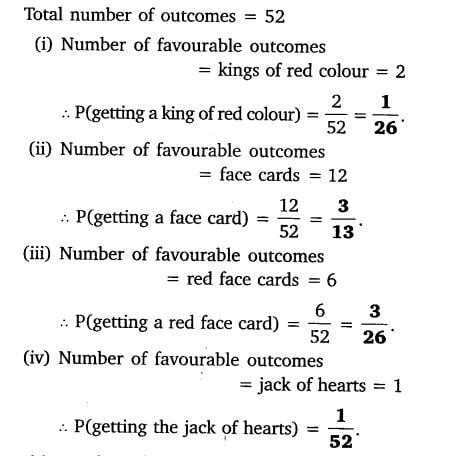
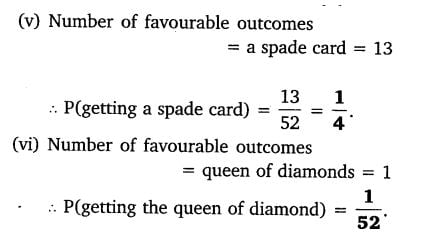
Class 10 Maths 14.1 NCERT Solutions Question 15.
15. Five cards, the ten, jack, queen, king and ace of diamonds, are well-shuffled with their face downwards. One card is then picked up at random.
(i) What is the probability that the card is the queen?
(ii) If the queen is drawn and put aside, what is the probability that the second card picked up is (a) an ace? (b) a queen?
Solution:

Class 10 Maths 14.1 NCERT Solutions Question 16.
16. 12 defective pens are accidentally mixed with 132 good ones. It is not possible to just look at a pen and tell whether or not it is defective. One pen is taken out at random from this lot. Determine the probability that the pen taken out is a good one.
Solution:

Class 10 Maths 14.1 NCERT Solutions Question 17.
17. (i) A lot of 20 bulbs contain 4 defective ones. One bulb is drawn at random from the lot. What is the probability that this bulb is defective?
(ii) Suppose the bulb drawn in (i) is not defective and is not replaced. Now one bulb is drawn at random from the rest. What is the probability that this bulb is not defective?
Solution:

Class 10 Maths 14.1 NCERT Solutions Question 18.
18. A box contains 90 discs which are numbered from 1 to 90. If one disc is drawn at random from the box, find the probability that it bears
(i) a two-digit number
(ii) a perfect square number
(iii) a number divisible by 5
Solution:
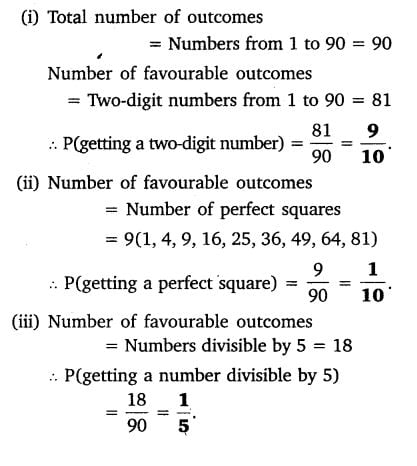
Class 10 Maths 14.1 NCERT Solutions Question 19.
19. A child has a die whose six faces show the letters as given below:
![]()
The die is thrown once. What is the probability of getting
(i) A?
(ii) D?
Solution:
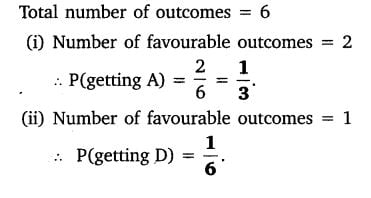
Class 10 Maths 14.1 NCERT Solutions Question 20.
20. Suppose you drop a die at random on the rectangular region shown in Fig. 15.6. What is the probability that it will land inside the circle with a diameter 1m?

Solution:

Class 10 Maths 14.1 NCERT Solutions Question 21.
21. A lot consists of 144 ball pens, of which 20 are defective, and the others are good. Nuri will buy a pen if it is good, but will not buy it if it is defective. The shopkeeper draws one pen at random and gives it to her. What is the probability that
(i) She will buy it?
(ii) She will not buy it?
Solution:
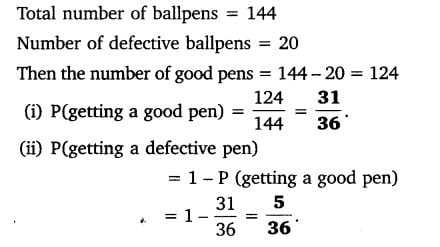
Class 10 Maths 14.1 NCERT Solutions Question 22.
22. Refer to Example 13. (i) Complete the following table:

(ii) A student argues that ‘there are 11 possible outcomes 2, 3, 4, 5, 6, 7, 8, 9, 10, 11 and 12. Therefore, each of them has a probability of 1/11. Do you agree with this argument? Justify your Solution:
Solution:
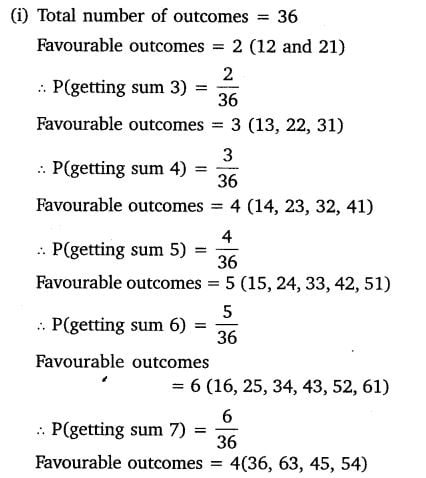
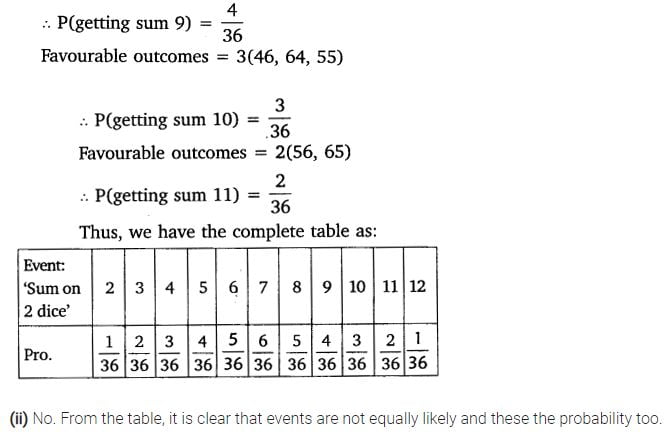
Class 10 Maths 14.1 NCERT Solutions Question 23.
23. A game consists of tossing a one-rupee coin 3 times and noting its outcome each time. Hanif wins if all the tosses give the same result, i.e. three heads or three tails, and loses otherwise. Calculate the probability that Hanif will lose the game.
Solution:

Class 10 Maths 14.1 NCERT Solutions Question 24.
24. A die is thrown twice. What is the probability that
(i) 5 will not come up either time?
(ii) 5 will come up at least once?
[Hint: Throwing a die twice and throwing two dice simultaneously are treated as the same experiment]
Solution:
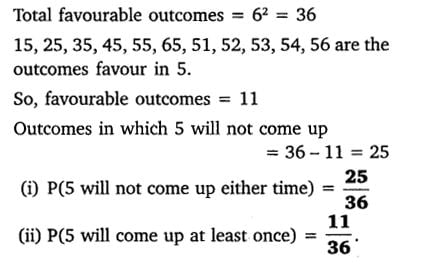
Class 10 Maths 14.1 NCERT Solutions Question 25.
25. Which of the following arguments are correct and which are not correct? Give reasons for your solution:
(i) If two coins are tossed simultaneously, there are three possible outcomes – two heads, two tails or one of each. Therefore, for each of these outcomes, the probability is 1/3
(ii) If a die is thrown, there are two possible outcomes – an odd number or an even number. Therefore, the probability of getting an odd number is 1/2
Solution:

Maths in Class 10: Probability
In Class 10 Maths 14.1 NCERT Solutions Students will talk about patterns in terms that come after those that come after by adding a certain number to the terms that came before in this chapter. Additionally, they see how to calculate the sum of n successive terms and the nth term. When students tackle real-world situations, they will successfully understand Probability.
As a result, these NCERT Solutions for Class 10 Maths will aid students in comprehending various question formats and their responses, in addition to providing important shortcuts and diagrammatic explanations. The Class 10 Maths Chapter 14 PDF NCERT Solutions are all provided in easy-to-understand manner. Students who fully understand these solutions will be able to solve challenging situations with ease.
The teachers have carefully selected the Class 10 NCERT Solutions to help students become more adept at solving problems. Students can consult Bhautik study materials for Surface areas and volumes for a clearer understanding.
Class 10’s Probability chapter 14 is part of the sixth unit, Statistics and Probability, which counts for ten of the exam’s eighty possible points. One such unit is unit 6, where marks are simple to assign after students understand the concept or procedure. Students will be able to thoroughly understand the strategies used to solve the problems in this chapter by completing the NCERT exercise questions. This will help the students get ready for the Class 10 Maths CBSE Board examination.
What is the Advantage of Class 10 Maths Class 10 Maths 14.1 NCERT Solutions Provided by Bhautik Study?
From the perspective of the CBSE Board test, it is crucial to practise these Class 10 NCERT Solutions. One of the maths chapters in Class 10 that covers topics most likely to be encountered in daily life is Probability. The chapter covers a variety of probability-related subjects, such as:
The distinction between theoretical and experimental probability
Why there is a one in the chance of a sure event, or certain event.
How can there be a zero probability of an impossible event?
Elementary events.
complementary occurrences.
Calculating the likelihood of certain events
class 10 maths 14.1 ncert solutions –
Students hoping to do well in this chapter can access the NCERT solutions for Class 10 Maths Chapter 14: Probability. With the help of these NCERT Solutions, which clearly explain the methods and procedures for solving the questions, students may easily and rapidly grasp the principles.
The world is very data-oriented; in fact, a set of data representing pertinent information exists in every field. The area of mathematics known as statistics is concerned with the meaningful representation of data.
You will come across numerous real-world situations where a set of data is represented in tabular form, graphs, or pie charts using the principles of statistics. This chapter will cover a variety of techniques, including how to discover the mode and median of grouped data, convert frequency distribution, and understand the relationship between mode, mean, and median techniques. The greatest study guides for the CBSE exam are the 10th Class NCERT solutions.
Important Elements of the NCERT Solutions for Math Class 10 Chapter 14
-Students can use the solutions for the statistics chapter as a guide.
-Students will find it useful to compare their scores to the questions posed by this chapter.
-Using this resource, students can get ready for and complete the revision for Chapter 13.
-Probability specialists have provided answers to the questions.
-The information is in line with the recommendations of the CBSE Syllabus (2024–25).
Using the various resources offered by Bhautik Study, statistics can also be comprehended more successfully. The solutions are designed to aid pupils in achieving high scores on the CBSE examinations.